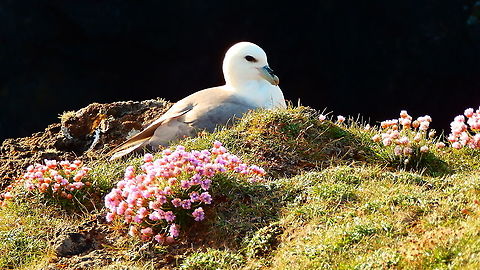
Appearance
The northern fulmar has a wingspan of 102 to 112 cm and is 46 cm in length. Body mass can range from 450 to 1,000 g.This species is gray and white with a pale yellow, thick, bill and bluish legs; however there is both a light morph and dark, or 'blue' morph. In the Pacific Ocean there is an intermediate morph as well. All morphs have certain similarities, such as only the dark morph has more than dark edges on the underneath, and they all have pale inner primaries on the top of the wings. The Pacific morph has a darker tail than the Atlantic morph.
Like other petrels, their walking ability is limited, but they are strong fliers, with a stiff wing action quite unlike the gulls. They look bull-necked compared to gulls, and have short stubby bills. They are long-lived, with a lifespan of 31 years not uncommon.
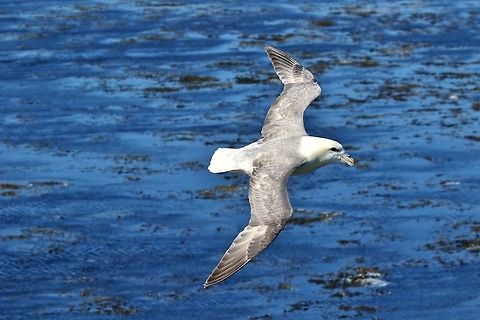
Naming
The northern fulmar consists of three sub-species:⤷ "F. g. glacialis" – : the nominate race, which breeds in the high Arctic regions of the North Atlantic
⤷ "F. g. auduboni" – Bonaparte, 1857: breeds in the low Arctic and boreal regions of the North Atlantic
⤷ "F. g. rodgersii" – Cassin, 1862: breeds on the coast of eastern Siberia and the Alaskan Peninsula"Fulmarus glacialis" can be broken down to the Old Norse word ' meaning "foul" and ' meaning "gull". "Foul-gull" is in reference to its stomach oil and also its superficial similarity to seagulls. Finally, ' is Latin for "glacial" because of its extreme northern range.
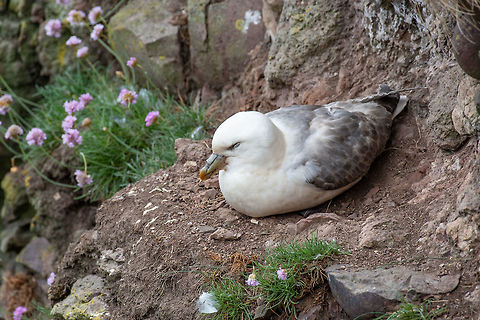
Status
The northern fulmar is estimated to have between 15,000,000 and 30,000,000 mature individuals, that occupy an occurrence range of 28,400,000 km2 and their North American population is on the rise, hence it is listed with the IUCN as Least Concern.The range of these species increased greatly last century due to the availability of fish offal from commercial fleets, but may contract because of less food from this source and climatic change. The population increase has been especially notable in the British Isles.
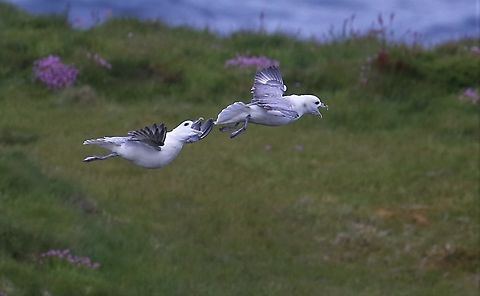
Behavior
The mating ritual of this fulmar consists of the female resting on a ledge and the male landing with his bill open and his head back. He commences to wave his head side to side and up and down while calling.They make grunting and chuckling sounds while eating and guttural calls during the breeding season.
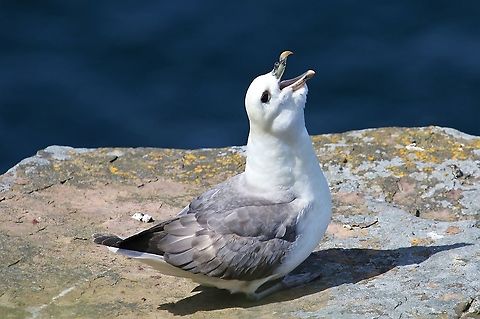
Reproduction
The northern fulmar starts breeding at between six and twelve years old. It is monogamous, and forms long term pair bonds. It returns to the same nest site year after year. The breeding season starts in May; however, the female has glands that store sperm to allow weeks to pass between copulation and the laying of the egg. Their nest is a scrape on a grassy ledge or a saucer of vegetation on the ground, lined with softer material. The birds nest in large colonies Recently, they have started nesting on rooftops and buildings. Both sexes are involved in the nest building process. A single white egg, 61 mm in size, is incubated for a period of 50 to 54 days, by both sexes. The altricial chick is brooded for 2 weeks and fully fledges after 70 to 75 days. Again, both sexes are involved. During this period, the parents are nocturnal, and will not even be active on well-lit nights.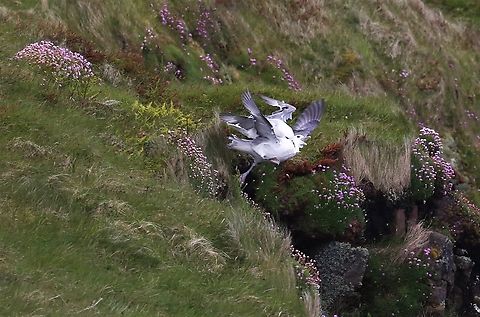
Food
This fulmar will feed on shrimp, fish, squid, plankton, jellyfish, and carrion, as well as refuse. When eating fish, they will dive up to several feet deep to retrieve their prey.References:
Some text fragments are auto parsed from Wikipedia.